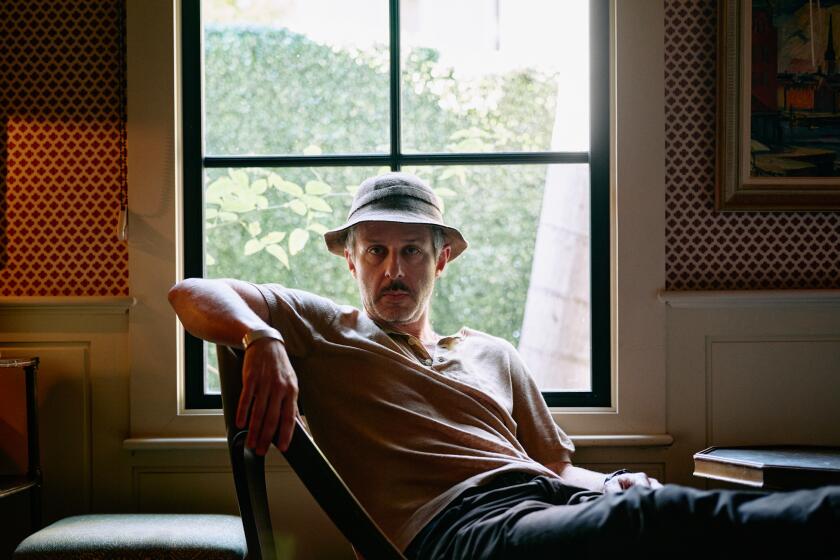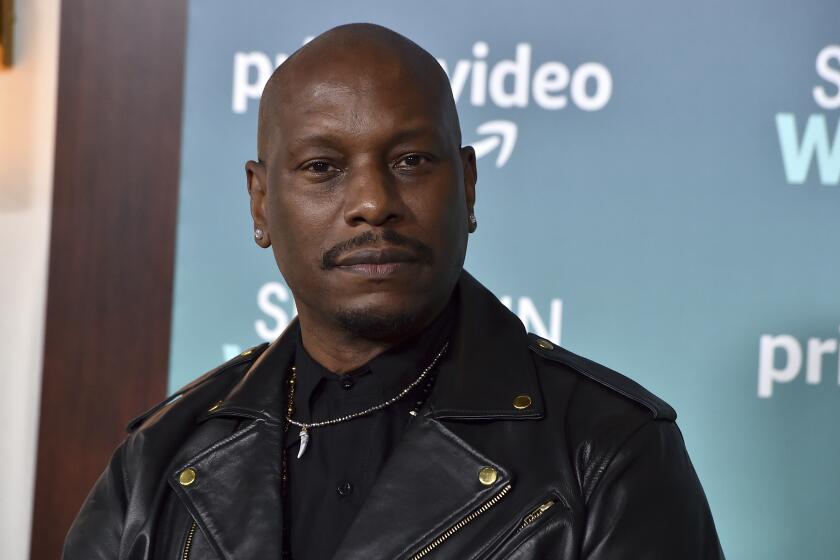Mick (the controlled one) and Keith (the relaxed one) are happy with Marty’s concert movie, ‘Shine a Light.’
NEW YORK — Mick JAGGER, dressed in lean, tailored perfection, was encamped recently in the bright, two-level tower suite atop the Carlyle Hotel on the Upper East Side, where he welcomed a visitor by offering a cup of English breakfast tea. Later that same day, 21 floors lower, Keith Richards greeted the same scribe with a rasping laugh and, with a Marlboro red and skull rings at his fingertips, held up a glass of vodka and orange soda on the rocks. “It’s called a nuclear waste. You want one?”
The music industry may be a diminished and uncertain mess this century, but the Rolling Stones, bless ‘em, still don’t disappoint or stray from the expected iconography; if anything, Richards seems to be going back in time with his pirate curtsy and eternal bluesman leer while Jagger, the whippet-thin rock star who once attended the London School of Economics, is the imperious archduke in full control. When his visitor pointed out that Jagger seems to be single-handedly keeping the Stones together through sheer force of will, the 64-year-old sighed through a smirk. “Oh,” he said, “do you think?”
It was in the same room at the Carlyle a few years ago during a bad storm that a skeptical Jagger met with Martin Scorsese and an early production team to discuss the prospects of a concert film. The result is “Shine a Light,” which arrives in selected theaters (and on IMAX screens) Friday and may boast the most accomplished team ever assembled to document a rock show. Scorsese brought in Oscar-winning cinematographer Robert Richardson (“JFK,” “The Aviator”) to lead a team of fellow Oscar winners in John Toll, Andrew Lesnie and Robert Elswit, whose collective resume includes “There Will Be Blood,” “Braveheart” and the “Lord of the Rings” franchise.
The “Shine a Light” team used swooping cameras to capture the Stones in the intimate confines of the Beacon Theatre, the grand old 2,800-seat palace on Broadway. For the film, the band tears through a 22-song set list with the usual-suspect hits (“Brown Sugar,” “Jumpin’ Jack Flash,” “Start Me Up”), some surprise excavations (like the rare revisiting of “As Tears Go By” with Richards on acoustic 12-string) and some guest stars (Jack White, Buddy Guy and, oddly, Christina Aguilera).
The finished film presents the Stones in high energy and bottled up on the stage of the vintage neo-Grecian theater. There’s also some odd off-stage material--the completely artificial booking was presented as a fundraiser and it was attended by the Clintons who greeted the band before the music played; as the band sniggers, the political family is presented as the square backstage admirers, the role Kevin Costner played in that old Madonna documentary. Scorsese appears on camera a lot, too, fretting and cajoling the band to give him a set list.
Jagger said afterward that the crowd was “not a good one, they were nice people, but not the kind of audience that is going to stir up the band.” His guitarist said the cheering and dancing in aisles was unimportant. “The show was a good one,” the 64-year-old Richards said, “but you have to know that it’s not just about the band, right? It’s about Martin Scorsese . . . it’s a rock show painted by a Rembrandt.”
It was a portrait that took some time, mostly because of the schedules of the principals. The show was staged in fall 2006. No one was more involved than Jagger, who was a persistent presence in every stage of the film. During the editing, he was the one pushing to keep the finished product lean. For instance, the film is peppered with vintage snippets of interviews with the Stones from the 1960s and 1970s, and many of them are amusing and some are even heartwarming.
“It’s got a light touch,” Jagger said. “It’s not some gloomy thing. There was a temptation to put more of those interviews in because they’re funny. But during the editing, I said, ‘No, cut it there. That’s enough.’ ” One reason was to keep the momentum of the stage performance going, but Jagger said a band with so much history needs to resist anything that starts to feel like a museum piece. “People have seen a lot of that before,” the singer said. Then, with an expression of mild weariness, Jagger said he still wasn’t sure the Stones needed another film document. “There’s quite a shelf full, already, don’t you think?”
Tarnish on their track record
There’s always been a whiff of danger to the Stones, of course, and it comes through in their history on camera. Most infamously, the 1970 film “Gimme Shelter” by the Maysles brothers documented the nightmarish scene the previous year at Altamont Speedway, where the Hells Angels were hired as security but went on a rampage. One 18-year-old concert-goer was stabbed and stomped to death.
There had been other dark tinges to the film library. The “Rock and Roll Circus” (recorded in 1968 but not released until 1996), directed by Michael Lindsay-Hogg, turned out to be a grim time capsule as the last public performance of Stones guitarist Brian Jones. The politically ominous “Sympathy for the Devil” (filmed in 1968 and released in 1970) was beset by a studio fire, the arrest of Jones on drug charges and a dispute between director Jean-Luc Godard and the producer that climaxed with a fistfight at the premiere. Then there was “Let’s Spend the Night Together,” directed by Hollywood rebel Hal Ashby, who filmed the band in 1981 at Arizona’s Sun Devil Stadium and then hours later was wheeled out of the band’s hotel on an ambulance gurney after slumping into a drug overdose.
There’s certainly reason to presume the shadowy hazards have receded as the band closes in on its fifth decade. In recent years, the Stones (down to the core quartet of Jagger, Richards, Ronnie Wood and Charlie Watts) have been starring in slick advertisements for mortgage companies and luxury sedans, so the sense of dark hazard is reduced significantly.
Don’t try telling that to Scorsese, who has a longtime romance for the encoded menace and vamping decadence of the Stones songbook. The director has used Stones music to great effect as a backdrop to scenes in “The Departed,” “GoodFellas” and “Casino,” and he jumped at a chance to film them.
Producer Victoria Pearman said the director quickly seized on the opportunity to add the Stones to his recent suite of music documentaries. Scorsese had the 2005 success of “No Direction Home: Bob Dylan” for PBS and, in 2003, the seven-part PBS series “Martin Scorsese Presents: The Blues.”
(Scorsese was not available for interviews, his representatives said, because of the work schedule for his next feature film, “Ashecliffe,” an adaptation of author Dennis Lehane’s “Shutter Island” that is due in theaters next year.)
The Stones certainly knew Scorsese could make a concert film -- he was the auteur behind arguably the greatest concert film of them all, “The Last Waltz,” the farewell show by the Band recorded in San Francisco on Thanksgiving 1976. This made Richards especially eager to work with him while, not surprisingly, Jagger came to an opposite point of view.
“I was very worried it would be a remake of ‘The Last Waltz,’ which was great, of course, but it was then. I was concerned that it would look like the ‘The Last Waltz,’ which is why I said no interviews. This needed to be different. Then there were other matters: How much was this going to cost? Who’s going to pay for it? Who’s going to release it? We were on tour, and this would require cutting a week out, for rehearsals, the shows, all of that . . . I was thinking, ‘Oh, um, do I really need this?’ I’m still thinking that.”
For Jagger the problems were in the months leading to the show, but for Richards the problems were during the show itself. At one point a female fan jeered him -- “You screwed up!” -- when he flubbed some chords. The salty Richards jeered right back: “Shaddup!” (Jagger and Scorsese got a good laugh from it in the editing room but softened the volume on his scream for the sake of the soundtrack.)
Richards also looked a bit flabbergasted right before the band launched into “Live With Me,” that raunchy classic from “Let It Bleed.” “This girl came out and I was, like, ‘Who is that?’ I had no idea.” It was Aguilera, one of the most famous pop singers in the world. “Yeah, that’s right. I don’t know. I’m still not sure who that is. She can sing, though. And she looked good.”
The show was assembled from a two-night stand and, like those old Stones movies, there was an unexpected tragedy. Ahmet Ertegun, the stately music executive who co-founded Atlantic Records and was a dear friend and supporter of the band, stumbled backstage and hit his head. He died within weeks. Jagger was asked about the grim footnote to the evening and, for once, seemed at a loss for words. Not Richards: “I know, it was awful. There we are on stage, rockin’, and there he is backstage, croaking. What can you do? I loved him. But you know, what better way to go? Backstage at a Stones show? That’s how I wanna go.”
When first conceived, “Shine a Light” (named after a song on the 1972 “Exile on Main Street” album) was going to be a “big” show -- Scorsese was going to bring his battery of cameras and document one of those massive Stones shows that approaches a NASA launch in its decibels and mission-control calculation. There was even talk of filming the Stones in Rio de Janeiro where a beach concert was expected to bring a million fans. But after seeing a few Stones shows in person, Scorsese wanted to zoom in, not out.
“At a certain point I thought making something more intimate would be suited to me as a filmmaker and would also facilitate a more personal connection between the audience and the band,” the director stated in the production notes.
Jagger was reluctant to go to a theater -- again, the “Last Waltz” problem -- but relented. “In the big shows, we’re on the same stage, but it’s like we’re not on the same planet,” Jagger said. “People like to see this interaction. This is what Martin was trying to get. If you’re on this very large stage, there’s a lot of moments when you’re not close together. In fact you’re hundreds of feet apart. If you’re forced to be in a smaller setting, it changes.”
It’s an on-screen surge
It’s an interesting time for the Stones and cinema. “This is quite a year, yes,” said Jagger, who with Diane English is producing “The Women,” a remake of the 1939 George Cukor film due in October. English is also writer and director, and the deep cast is lead by Meg Ryan, Annette Bening, Eva Mendes and Debra Messing. Jagger also has another project underway, “Ruby Tuesday,” an animated film that features the music of the band. “It’s an animated film with Stones songs, not an animated film with the Stones, get that straight,” said Jagger, clearly worried that the band isn’t the sort that should be climbing inside a yellow submarine.
Well, maybe Richards could pull off the maritime cartoon. After Johnny Depp’s channeling of Richards in the “Pirates of the Caribbean” series and the rocker’s cameo as Jack Sparrow’s father, the salty old guitar hero is reveling in his new role as the world’s pirate laureate. “I keep getting scripts, can you believe that? All these people want to put me in movies now. It’s very unusual.”
Jagger seemed long ago to give up on his aspiration of a Hollywood career, and when asked about his bandmate’s accidental career as bleary icon, he chose his words carefully. The band has survived these many decades by giving each other room and keeping their interviews on separate floors. Richards, seemingly without malice, caused a stir recently by referring to Jagger as “a dictator,” but the more careful singer wasn’t going to fire a cannonball that might mess up the Stones balance.
“He needs a parrot, right? I don’t know . . .” Jagger chuckled and tapped his teacup, searching for the right words. “He’s an icon, I suppose, an iconic pirate. I guess . . . people evolve these characters throughout their lives. And it’s interesting to watch. I hope he’s not going to have a peg leg. I hope it doesn’t come to that. But, you know, it could.”
--
More to Read
Only good movies
Get the Indie Focus newsletter, Mark Olsen's weekly guide to the world of cinema.
You may occasionally receive promotional content from the Los Angeles Times.










